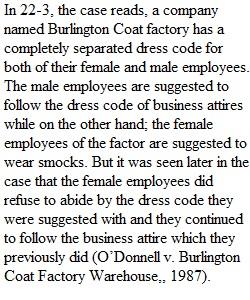


Q A) Burlington Coat Factory Ware- house, Inc., had a dress code that required male salesclerks to wear business attire consisting of slacks, shirt, and a neck- tie. Female salesclerks, by contrast, were required to wear a smock so that customers could readily identify them. Karen O’Donnell and other female employees refused to wear the smock. Instead they reported to work in business attire and were suspended. After numerous suspensions, the female employees were fired for violating Burlington’s dress code policy. All other conditions of employment, including salary, hours, and benefits, were the same for female and male employees. Was the dress code policy discriminatory? Why or why not? [O’Donnell v. Burlington Coat Factory Warehouse, Inc., 656 F.Supp. 263 (S.D. Ohio 1987)] (See Employment Discrimination.)B) Why has the federal government limited the application of the statutes discussed in this chapter to firms with a specified number of employees, such as fifteen or twenty? Should these laws apply to all employers, regardless of size? Why or why not?
View Related Questions